
Wine Culture and Information since 2002 - Volume 22
 Wine Culture and Information since 2002 - Volume 22 |
|
Tasting Sweet and Botrytised WinesRich and enchanting aromas, intense and charming flavors: the magic of sweet and botrytised wines is a combination of art and mystery, a pleasure which surprises every wine lover's senses |
|
Among the many types of wines, the ones which are capable more than any other else to evoke rich emotions and to excite senses the most are probably sweet and botrytised wines. In the course of centuries these wines have always been appreciated and looked for in every place, considered real and proper nectars for their aromatic qualities and for their enchanting and intense flavors. They were also considered as medicines and reconstituents; it is often cited in ancient documents that doctors prescribed these wines as a cure. The charm of these wines could also be because of the fact they are usually produced in limited quantities and in tiny areas, two factors which certainly contribute to make rare, and therefore precious and valuable, these genuine nectars of grape.
|
|
The production of sweet wines, with the exception of sweet sparkling wines, are always based on the usage of grapes which lost part of their water while obtaining a concentration of juice and a higher quantity of sugar. The reduction of water in grape's berries is a natural process which takes place in two different ways: by leaving bunches on the vine and waiting for berries to get dried, or to harvest grape when it reached full maturation and to let it dry in protected and well aerated rooms, placed in mats or hanged. The most common method is the one of allowing bunches to get dried on the vine, mainly in those places where particular climatic conditions promote the development of a mould, apparently a negative factor, which in reality adds unique and extraordinary characteristics to the wine. This particular mould, to be considered as a real and proper blessing, whose scientific name is Botrytis Cinerea, is capable of giving grapes where it gets developed, truly unique aromas and flavors and, because of its effects, it greatly contributes to water reduction in grape's berries. The development of this mould, usually called noble rot, exclusively takes place in areas where particular environmental and climatic conditions allow its formation on the skin of grape's berries. The effect of noble rot in sweet wines, for this reason they are also called botrytised wines, is always a positive factor because it is capable of giving wine unique and extraordinary aromas and flavors, very difficult to explain with words or with the help of analogy, and they become absolutely unmistakable after having perceived them for the first time. The most common and frequent definitions used to describe the aromas added by noble rot to wine include honey, spices, apricot, hazelnut, toffee and caramel; honestly no one of them can describe it fully, maybe they can just give a vague idea, what it is certain is that aroma of Botrytis Cinerea is unique, pleasing, elegant and very appreciated. This precious mould is called muffa nobile in Italian, pourriture noble in French, edelfäule in German and Aszú in Hungarian; in every country is always and however welcome in vineyards and allows the production of great, magnificent wines.
The first witness about the discovery of noble rot's effects on wine is dated back to the half of seventeenth century by a Hungarian priest, but it seems it was already known to Greeks more than 2000 years ago. The development of noble rot, which needs particular environmental and climatic conditions, in particular favorable conditions of humidity, is frequent in certain areas of Hungary, Austria, Germany, France, Italy, Australia and North America. The development of noble rot is pretty unpredictable, it requires good humidity for its formation and a dry climate in order to survive. The repetition of these climatic conditions and in subsequent days, in particular cool and moist nights followed by warm and dry days, ensure the development of noble rot which usually appears on grapes after two or three days. Noble rot usually prefers white berried grapes having a pretty thick skin and with compact bunches, and in case climatic conditions are not favorable, in particular when humidity is excessive and prolonged, it could easily degenerate into another type of mould having opposite effects: grey rot, a factor which irremediably ruins grapes and therefore cannot be used for producing wine. The development of noble rot in vineyards truly is a preoccupying event for every viticulturist because in case conditions are not favorable, precious and valuable grapes can turn into unusable and rotten grapes, a preoccupation that ends only after harvesting. When the spores of Botrytis Cinerea get in contact with the moist skin of grape, usually transported by wind, they start consuming the water on skin's surface and therefore they increase in dimension. At this point begins the development of a germinal tube which holes the skin in the aim of searching nourishment. As the mould gets into the berry, and also thanks to the huge quantity of nutrients, the development is pretty rapid and the surface of the skin gets literally covered by noble rot. Holes made by spores in the skin promote the reduction of water, therefore concentrating sugar and aromatic substances. The effect of noble rot continues by transforming some substances present in grapes and get mixed to them therefore adding its aroma and its flavor. At the end of the process grape's berries have a look which is not certainly inviting, apparently rotten, but on the inside took place unique magic that will give origin to a divine nectar.
|
||||||||
|
Typical colors of sweet and botrytised wines depend, first of all, by the species of grapes used for their production. In sweet red wines, such as Recioto della Valpolicella or Sagrantino di Montefalco Passito, the range of colors is pretty common, usually ruby and garnet red, very deep and most of the times impenetrable by light, with nuances of garnet red. In sweet white wines the range is wider and colors can go from golden yellow to amber yellow, sometimes very dark. The color of sweet white wines mainly depends by the way grapes were dried as well as the type of grape. Generally speaking sweet wines produced with grapes dried after harvesting usually have deeper and darker colors and tend to amber yellow, such as Vin Santo produced in Umbria and Tuscany or Moscato di Pantelleria Passito. It should be however remembered that amber color could also be the sign of oxidation, sometimes wanted by the producer in order to give wine particular organoleptic qualities. Sweet white wines produced with grapes dried on the vine and, in particular, grapes affected by noble rot, such as Sauternes, German and Austrian sweet wines, as well as botrytised wines produced in Orvieto (Umbria), are characterized by splendid golden yellow colors, brilliant and intense, however amber yellow is frequent as well, such as the one of Tokaji Aszú. The color of sweet white wines tends to get darker with the aging in bottle, changing from golden yellow to dark golden yellow and then to amber yellow.
|
|
Aromatic characteristics of sweet wines produced with dried grapes are pretty complex and change according to the type. A characteristic which is usually common to every sweet wine produced with dried grapes is the richness and intensity of aromas, sometimes seems that every time the glass is being smelt a new aroma is coming out from it and the list seems to be endless. In sweet wines produced with red berried grapes will be frequent aromas of red and black skinned fruit, such as plum, strawberry, blackberry, black cherry, cherry, blueberry, raspberry and black currant, sometimes also perceived as jams made with those fruits. Dried flowers can be found as well, such as violet and rose, as well as particular aromas, such as chocolate and cocoa, and spices, such as cardamom, cinnamon and vanilla, in case the wine was aged in cask. In sweet white wines the aromatic range is certainly more variegated and complex. In sweet wines produced with aromatic grapes, such as Moscato di Pantelleria, Malvasia delle Lipari and Moscato Passito di Chambave, the aroma of grape will be very pronounced, often resembling raisin. In wines produced with grapes affected by noble rot, such as Sauternes, Tokaji Aszú and Muffato di Orvieto as well as German and Austrian sweet wines, the aromatic effect of Botrytis Cinerea will be evident and often very pronounced. The pleasing and elegant aroma of noble rot is, like we already said, pretty hard to define with words or with the help of analogy, many have compared it to the one of honey, spices, apricot, hazelnut, toffee and caramel, no one of them really resemble to it, maybe, it could be defined as a combination of them all in different proportions. In these wines is the aromatic range of fruit to dominate, most of the time it is dried fruit and jams, such as apricot, peach, quince, pear, apple and fig, as well as tropical fruit, such as banana, litchi, mango and pineapple. Common are also aromas of flowers, often dried, such as acacia, orange blossom and broom. The aromatic series in sweet white wines continues with aromas of candied fruit, in particular orange peel and other citrus fruits, honey of many types of flowers, caramel, chocolate, croissant, almond and hazelnut. Sometimes can also be found aromas of spices, such as cinnamon, anise and vanilla, in particular when the wine was aged in wood containers. Typical aromas in sweet white wines are countless and, in general terms, very complex, in wines aged in bottle for many years the aromatic range gets richer, often so surprising that one would not even expect to find them in a wine.
|
||||
|
As a sweet wine enters the mouth, it is more likely the impact is pretty surprising. Its flavors are usually intense, having a good correspondence to the aromas perceived by the nose, sweetness is clearly perceivable from the very beginning and a pleasing sensation of velvety roundness pervade the mouth. A pleasing characteristic of these wines is their very long taste olfactory persistence, like no other wine. It is not rare to find a sweet wine with a taste olfactory persistence longer than 15 seconds and sometimes they can even be measured in minutes instead of seconds. Despite the fact this premise could make sweet wines appear like a heavenly nectars, and they certainly can be like that, what makes these wines pleasing and extraordinary to the taste is their balance. Because of the presence of sugar, these wines could taste sickly and syrupy in case they are not properly balanced by other components. Because of the different quantities of substances present in white and red sweet wines, it is necessary to distinguish balance of the two types. The characteristic common to both is certainly alcohol and sugar, whereas in sweet red wines it is common the presence of tannins, and therefore of the tactile sensation of astringency; in white sweet wines the quantity of acid is higher, usually can be appreciated to the taste as well. The critical factor in sweet wines is represented by the quantity of residual sugar and from this factor also depends the whole balance. Alcohol, which basically has a sweet taste, partially has a role in the balance of sugar as its pseudo caloric action lowers the relative perception of sugar. In sweet red wines, where tannins can be found, sugar has a balancing function for astringency as it basically tends to attenuate it, the same function is also done by alcohol. Moreover it should be remembered sugar tends to slow down the perception of astringency. In sweet white wines it will be acidity to play an important role for balance. Sweetness and acidity tend to balance one each other, sugar will therefore balance a very acid wine, whereas acid will avoid a wine to taste sickly or syrupy. This is the specific case of German sweet wines, despite the fact they have a high acidity, they are very balanced thanks to the mutual tendency of these two components to balance each other: the wine will never be sickly nor acid, but perfectly and pleasingly balanced.
|
|
In this practical application on sweet and botrytised wines we will use three wines having particular characteristics: an aromatic sweet wines, a sweet wine and a botrytised wine. We will examine a Moscato di Pantelleria Passito, a Vin Santo from Umbria or Tuscany, and a Muffato di Orvieto. Despite there is a very personal preference about serving temperatures for sweet wines, in our case we will taste the wines at a temperature of 14° C (57° F) in order not to penalize the development of aromas and without excessively enhancing sweetness. In the evaluation of appearance the three wines will have very different colors whereas “consistency” and viscosity will seem to be the same: by rotating the glass it will be noted a higher density of the liquid if compared to any other wine. Moscato di Pantelleria Passito will show an amber yellow color tending to a pale tint; Vin Santo will be the one having a deeper and more intense color compared to the others, in this wine the amber yellow color will be darker and deeper. The Muffato wine will show a brilliant and intense golden yellow color. To the nose the three wines will offer very different olfactory perceptions, however they will all be characterized by a strong intensity of aromas. In the Moscato di Pantelleria Passito it will be perceived, in the beginning, a pronounced and pleasing aroma of grape, a primary characteristic of the wine, followed by aromas of dried fruit and jam, such as dried apricot, candied fruit, peach jam, almond, dried fig, citrus fruit peel and orange marmalade. Moreover will be perceived aromas of tropical fruit such as litchi. The aromas of Vin Santo will seem to be more complex and in particular it will be perceived a clear aroma of fig jam and caramel, as well as aromas of jams, such as apricot and peach, and dried fruit, such as dried fig, almond, dried apricot and raisin. Other aromas that can be found in Vin Santo include honey and vanilla, in case the wine was aged in casks, according to the traditional process for the production of this wine. In the Muffato di Orvieto the aroma of noble rot will clearly be perceivable from the very beginning. This aroma, truly particular, is pretty hard to describe by means of words, however it is easily recognizable after having perceived it for the fist time. The aromatic series of botrytised wine continues with intense aromas of dried apricot, honey, apricot and peach jam, candied fruit, orange peel, as well as orange blossom and broom. Aromas of tropical fruit can be perceived as well, such as banana, pineapple and litchi. During the gustatory analysis, the three wines will be noticed for their common characteristic: sweetness. This taste will be the first one to be perceived and there will be a clear and strong sensation of roundness in the oral cavity, a sensation almost syrupy without being sickly. In all three wines the correspondence to the nose will be truly convincing: the pleasing aromas perceived to the nose have now become flavors. Then it will be evaluated the balance and the relations among alcohol, sugar and acidity: despite the fact sweetness will be the main gustatory characteristic of the three wines, particular attention will be paid to the role played by the pseudo caloric sensation of alcohol that will tend to diminish its perception, as well as acidity, and each one of these wines has a different quantity of acid, that will have the function of balancing sweetness. The most surprising characteristic of the three wine will probably be their taste olfactory persistence, also known as PAI (Intense Aromatic Persistence). Flavors and tastes will be clearly perceivable even after having swallowed the wine and they will even continue to be perceivable after a truly unusual length of time, not common for other wines, often measurable in minutes instead of seconds.
|
Wines of the Month |
|
|
|
Score legend Prices are to be considered as indicative. Prices may vary according to the country or the shop where wines are bought |
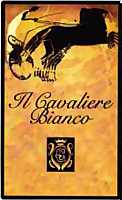
|
|
Il Cavaliere Bianco 2001 |
|
| Fratelli Casali (Italy) | |
| Grapes: Trebbiano Romagnolo | |
| Price: € 3,20 | Score: |
| This wine shows an intense greenish yellow color and nuances of greenish yellow, very transparent. The nose reveals clean and pleasing aromas of chamomile, almond, pear, apple, hawthorn, grapefruit and hints of elder. In mouth has good correspondence to the nose, in particular the aroma of chamomile, good balance and intense flavors. The finish is persistent with flavors of chamomile and apple. | |
| Food Match: Appetizers, Dairy products, Soft cheese, Pasta and risotto with vegetables | |

|
|
Sangiovese di Romagna Superiore Riserva 2000 |
|
| Fratelli Casali (Italy) | |
| Grapes: Sangiovese | |
| Price: € 10,00 | Score: |
| The wine shows a brilliant ruby red color and nuances of rube res, moderate transparency. The nose reveals intense, clean, pleasing and elegant aromas of black cherry jam, plum jam, blueberry, licorice and violet followed by pleasing hints of camphor and vanilla. In the mouth has good correspondence to the nose, a slightly tannic attack however well balanced, intense flavors and full body. The finish is persistent with flavors of black cherry, plum and blueberry. This wine ages in barrique for about 13 months. | |
| Food Match: Braised and stewed meat, Game, Roasted meat, Hard cheese | |
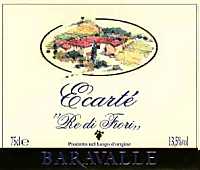
|
|
Ecarté Re di Fiori 2002 |
|
| Baravalle (Italy) | |
| Grapes: Muscat Blanc | |
| Price: € 7,00 | Score: |
| The wine shows a light straw yellow and nuances of greenish yellow, very transparent. The nose reveals intense, pleasing, elegant and refined aromas where the good aromaticity of the grape is clearly evident. There can be perceived aromas of peach, apricot, litchi, apple, melon, pear, broom and hawthorn followed by pleasing aromas of sage and vanilla. In the mouth has good correspondence to the nose, intense flavors and good balance, agreeable crispness. The finish is persistent with flavors of peach, pear and melon. This wine is fermented in barrique. | |
| Food Match: Appetizers, Crustaceans, Pasta and risotto with fish | |
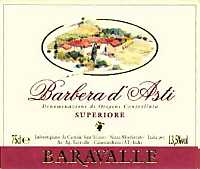
|
|
Barbera d'Asti Superiore 1998 |
|
| Baravalle (Italy) | |
| Grapes: Barbera | |
| Price: € 7,20 | Score: |
| This wine has an intense ruby red color and nuances of ruby red, moderate transparency. The node denotes intense, clean and pleasing aromas of black cherry, blueberry, plum and violet followed by pleasing hints of vanilla and carob. In the mouth has good correspondence to the nose, good balance and pleasing to drink, good tannins, intense flavors and good body. The finish is persistent with flavors of plum, black cherry and blueberry. This Barbera is aged for at least 12 months in barrique. | |
| Food Match: Roasted meat, Braised meat, Hard cheese | |
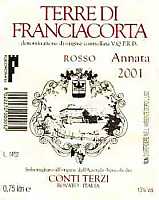
|
|
Terre di Franciacorta Rosso 2001 |
|
| Conti Terzi (Italy) | |
| Grapes: Barbera, Cabernet, Nebbiolo, Merlot | |
| Price: € 4,80 | Score: |
| The wine shows an intense ruby red color and nuances of ruby red, moderate transparency. The nose has intense, clean and pleasing aromas of black cherry, raspberry, blueberry, plum and violet. In the mouth has good correspondence to the nose, a slightly and pleasing crisp attack however balanced by alcohol, good tannins, intense flavors and goof body. The finish is persistent with flavors of plum, black cherry and blueberry. | |
| Food Match: Roasted meat, Sauteed meat, Hard cheese | |
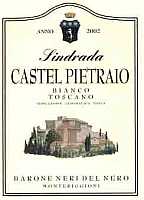
|
|
Sindrada 2002 |
|
| Fattoria di Castel Pietraio (Italy) | |
| Grapes: Chardonnay (90%), Malvasia Bianca (10%) | |
| Price: € 6,00 | Score: |
| The wine shows a brilliant straw yellow color and nuances of straw yellow, very transparent. The nose reveals intense, clean and pleasing aromas of citrus fruits, pineapple, hawthorn, almond, apple, pear, peach and plum. In the mouth has good correspondence to the nose, a slightly sweet attack which does not disturb and however well balanced by crispness, good body and intense flavors. The finish is persistent with flavors of peach, pear and plum. | |
| Food Match: Pasta and risotto with vegetables, Sauteed fish, Sauteed white meat | |
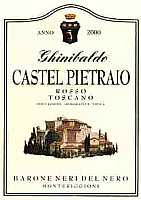
|
|
Ghinibaldo 2000 |
|
| Fattoria di Castel Pietraio (Italy) | |
| Grapes: Sangiovese (80%), Merlot (20%) | |
| Price: € 18,50 | Score: |
| This wine shows a deep ruby red color and nuances of ruby red, little transparency. The nose reveals good personality and intense, pleasing, clean and elegant aromas which open up with black cherry jam, plum jam and a hint of vanilla followed by pleasing and good aromas of violet, blueberry, carob as well as hints of cocoa, licorice and eucalyptus. In the mouth has good correspondence to the nose, a slightly tannic attack however balanced by alcohol, intense flavors and good body. The finish is persistent with good and intense flavors of plum, black cherry and blueberry. A well made wine. Ghinibaldo is aged for 12 months in barrique. | |
| Food Match: Braised and stewed meat with mushrooms, Roasted meat, Game, Hard cheese | |
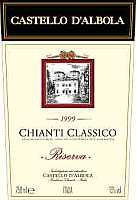
|
|
Chianti Classico Riserva 1999 |
|
| Castello d'Albola (Italy) | |
| Grapes: Sangiovese, Canaiolo Nero | |
| Price: € 14,60 | Score: |
| The wine shows a brilliant ruby red color and nuances of ruby red, moderate transparency. The nose has clean, pleasing and elegant aromas of black cherry, blueberry, plum and violet followed by good hints of carob, licorice and vanilla. In mouth reveals good correspondence to the nose, a slightly tannic attack however balanced by alcohol, intense flavors and good body. The finish is persistent with flavors of plum, black cherry and blueberry. This Chianti Classico ages for 15 months in barrique followed by 12 months in steel tanks and 4 months in bottle. | |
| Food Match: Braised meat with mushrooms, Roasted meat, Broiled meat and barbecue, Hard cheese | |
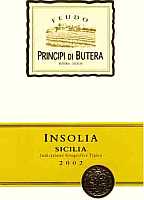
|
|
Insolia 2002 |
|
| Feudo Principi di Butera (Italy) | |
| Grapes: Inzolia | |
| Price: € 8,30 | Score: |
| This wine shows a light straw yellow color and nuances of greenish yellow, very transparent. The nose denotes intense, pleasing and clean aromas of pineapple, almond, apple, hawthorn, broom, pear and peach. In the mouth has good correspondence to the nose, good balance, good body, intense flavors and agreeable crispness. The finish is persistent with clean flavors of peach, pear and apple. Insolia is ages for some months in bottle. | |
| Food Match: Fish appetizers, Pasta and risotto with vegetables and fish, Fish soups | |
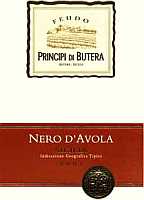
|
|
Nero d'Avola 2001 |
|
| Feudo Principi di Butera (Italy) | |
| Grapes: Nero d'Avola | |
| Price: € 11,00 | Score: |
| This wine shows an intense ruby red color and nuances of ruby red, little transparency. The nose reveals good personality with clean and pleasing aromas of plum jam, raspberry, blueberry and cyclamen followed by good hints of white pepper and vanilla. In mouth denotes good correspondence to the nose, a slightly tannic attack however balanced by alcohol, good body and intense flavors. The finish is persistent with flavors of plum jam, raspberry and blueberry. This wine ages for 12 months in cask. | |
| Food Match: Braised meat with mushrooms, Roasted meat, Hard cheese | |
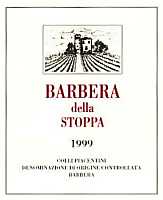
|
|
Colli Piacentini Barbera della Stoppa 1999 |
|
| La Stoppa (Italy) | |
| Grapes: Barbera | |
| Price: € 9,50 | Score: |
| This wine shows a deep ruby red color and nuances of ruby red, little transparency. The nose reveals good personality with intense, clean, elegant and pleasing aromas which open up with violet, black cherry and blackberry followed by pleasing and intense aromas of blueberry, plum, licorice and vanilla. In the mouth has good correspondence to the nose, a slightly and pleasing crisp attack however well balanced, good tannins, intense flavors and good body. The finish is persistent with good flavors of plum, blueberry and black cherry. A well made wine. This Barbera is aged for 12 months in barrique. | |
| Food Match: Braised and stewed meat with mushrooms, Roasted meat, Game, Hard cheese | |

|
|
Colli Piacentini Malvasia Passito Vigna del Volta 2001 |
|
| La Stoppa (Italy) | |
| Grapes: Malvasia Bianca (80%), Muscat Blanc (20%) | |
| Price: € 16,00 - 500 ml (16.9 fl.ozPiquant and hard cheese, Confectionery, Fruit tarts | Score: |
| This sweet wine shows a light amber yellow color and nuances of golden yellow, very transparent. The nose reveals clean, pleasing, refined and elegant aromas of dried apricot, candied fruit, caramel, peach jam, dried fig, almond, honey and citrus fruit peel followed by a pleasing hint of vanilla. In the mouth has good correspondence to the nose, a round and sweet attack which is continuously perceivable, intense flavors. The finish is persistent with flavors of caramel, apricot and peach jam. Vigna del Volta is produced with grapes allowed to dry for two weeks and ages for 10 months in barrique. | |
| Food Match: Piquant and hard cheese, Confectionery, Fruit tarts | |

|
|
Collio Ribolla Gialla 2002 |
|
| Venica (Italy) | |
| Grapes: Ribolla Gialla | |
| Price: € 12,60 | Score: |
| This wine shows a light straw yellow color and nuances of greenish yellow, very transparent. The nose denotes intense, clean, pleasing and elegant aromas of apple, orange, almond, hawthorn, pear and grapefruit followed by pleasing hints of lavender. In the mouth has good correspondence to the nose, a pleasing crisp attack however balanced by alcohol, intense flavors and good body. The finish is persistent with clean and pleasing flavors of grapefruit, pear and apple. A well made wine. | |
| Food Match: Fish appetizers, Pasta and risotto with fish and vegetables, Sauteed fish | |
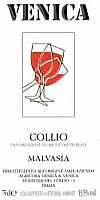
|
|
Collio Malvasia 2002 |
|
| Venica (Italy) | |
| Grapes: Malvasia Istriana | |
| Price: € 12,60 | Score: |
| This wine shows a brilliant straw yellow color and nuances of straw yellow, very transparent. The nose reveals intense, pleasing, elegant and refined aromas of banana, hawthorn, apple, hazelnut, pear and peach followed by pleasing hints of avocado and rosemary. In the mouth has good correspondence to the nose, a slightly crisp attack however well balanced, intense flavors, good body. The finish is persistent with pleasing flavors of peach, pear and banana. | |
| Food Match: Fish appetizers, Crustaceans, Pasta and risotto with fish, Sauteed fish, Sauteed white meat | |
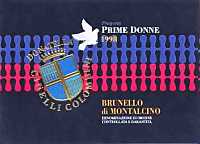
|
|
Brunello di Montalcino Progetto Prime Donne 1998 |
|
| Donatella Cinelli Colombini (Italy) | |
| Grapes: Sangiovese | |
| Price: € 27,50 | Score: |
| The wine shows an intense ruby red color and nuances of garnet red, moderate transparency. The nose reveals good personality with elegant, refined, clean and very pleasing aromas of black cherry, strawberry jam, raspberry jam, plum jam and violet followed by good aromas of cinnamon, chocolate, licorice, thyme and vanilla. In the mouth has good correspondence to the nose, a slightly tannic attack however well balanced by alcohol, intense flavors and full body. The finish is persistent with pleasing and clean flavors of plum, raspberry and strawberry. A very well made wine. Progetto Prime Donne ages for two years in cask. | |
| Food Match: Game, Roasted meat, Braised and stewed meat, Hard cheese | |
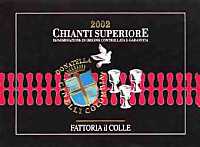
|
|
Chianti Superiore 2002 |
|
| Donatella Cinelli Colombini (Italy) | |
| Grapes: Sangiovese (90%), Canaiolo Nero (10%) | |
| Price: € 8,50 | Score: |
| The wine shows a brilliant ruby red color and nuances of purplish red, moderate transparency. The nose has very pleasing aromas of fruit, as well as intense and elegant aromas of black cherry, cherry, strawberry, raspberry and plum followed by pleasing aromas of anise, cyclamen and violet. In the mouth has good correspondence to the nose, a slightly tannic attack however well balanced by alcohol, intense flavors and good body. The finish is persistent with pleasing flavors of strawberry, raspberry and plum. | |
| Food Match: Broiled meat and barbecue, Stuffed pasta, Sauteed meat, Hard cheese | |
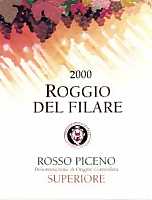
|
|
Rosso Piceno Superiore Roggio del Filare 2000 |
|
| Ercole Velenosi (Italy) | |
| Grapes: Montepulciano (80%), Sangiovese (20%) | |
| Price: € 18,00 | Score: |
| This wine shows a beautiful and deep ruby red color and nuances of ruby red, little transparency. The nose has personality with intense, clean, refined, elegant and pleasing aromas of black cherry, carob, blueberry, blackberry, black currant, plum and violet followed by intense and good aromas of caper, ink, licorice, leather, black pepper and vanilla. In the mouth has good correspondence to the nose, a slightly tannic attack however balanced by alcohol, intense flavors and full body. The finish is persistent with good and intense flavors of black cherry, blueberry and plum. A very well made wine. Roggio del Filare ages in barrique. | |
| Food Match: Braised and stewed meat, Roasted meat, Game, Hard cheese | |
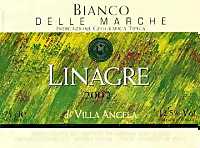
|
|
Linagre 2002 |
|
| Ercole Velenosi (Italy) | |
| Grapes: Sauvignon Blanc, Pecorino | |
| Price: € 7,90 | Score: |
| The wine shows a beautiful and soft straw yellow color and nuances of greenish yellow, very transparent. The nose reveals intense, pleasing, clean, refined and elegant aromas where the Sauvignon Blanc grape is clearly perceivable from the beginning. The wine opens up with fresh and good aromas of elder flower, broom, peach, pear and pineapple followed by intense and good aromas of banana, litchi, melon, grapefruit as well as hints of bell pepper. In the mouth has good correspondence to the nose, a pleasing crisp attack however well balanced, good body and very agreeable. The finish is persistent with pleasing and good flavors of peach, pineapple and melon. A well made wine. | |
| Food Match: Sauteed white meat, Pasta and risotto with fish, Sauteed fish, Soft cheese | |

|
|
Rêve 2001 |
|
| Ercole Velenosi (Italy) | |
| Grapes: Chardonnay | |
| Price: € 15,00 | Score: |
| The wine shows a beautiful and intense straw yellow color and nuances of straw yellow, very transparent. The nose opens up with an intense hint of toasted wood followed by elegant, intense, clean and pleasing aromas of banana, coffee, pineapple, acacia, grapefruit, peach, vanilla, apple, litchi and pear as well as hints of toasted bread. In the mouth has good correspondence to the nose, a slightly alcoholic attack however balanced, good body and intense flavors. The finish is persistent with good flavors of pear, vanilla, banana and pineapple. A well made wine. Rêve is produced with late harvested grapes and ferments in barrique. | |
| Food Match: Stuffed pasta, Fried vegetables, Roasted fish, Sauteed meat, Soft cheese | |
|
||||||||
|
DiWineTaste Polls
|
| |||||||
Privacy Policy | |||||||


| Copyright © 2002-2024 Antonello Biancalana, DiWineTaste - All rights reserved |
| All rights reserved under international copyright conventions. No part of this publication and of this WEB site may be
reproduced or utilized in any form or by any means, electronic or mechanical, without permission in writing from DiWineTaste. |